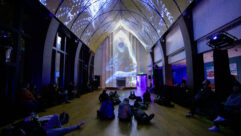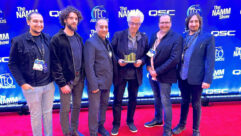
Government Installation Issues
Nov 1, 2007 12:00 PM,
By Dan Daley
Experts discuss challenges in security, budget, and technology.

The new Library of Congress National Audiovisual Conservation Center in Culpeper, Va., features several rooms like this one for converting original audio recordings to digital format for storage and archiving.
Installing AV and other media systems for government clients is a multidimensional proposition. The bureaucracy and procedural process can often be as complex as the technology itself. In this article, we’ll survey a number of systems integrators who pool their experience on municipal, state, and federal installation projects to bring a tactile sense of scope to the issues and challenges involved with this unique market.
Participants include Steve Stanford, senior systems integrator at Allied Sound in Nashville, Tenn.; David Giblin, vice president and general manager for Communications Engineering (CEI) in Newington, Va.; Paul Culbertson, marketing and sales at JAVS in Louisville, Ky.; and Anthony Hammond, AV systems sales engineer at Comprehensive Technical Group (CTG) in Atlanta.
What sets a government installation project apart from commercial projects, in terms of technology, process, and procedure? Do government clients prefer not to push the boundaries of technology?
Stanford: Most of our government projects have been very strict in terms of equipment choices, installation techniques, and even value-engineering options. They typically have a consultant involved of some nature. As for the process, certain government sites and projects are in a much higher-security area, and may involve some level of background checks for everyone who may work onsite. Depending on the project, all the equipment may also have to be checked out and pass through a security checkpoint.
Dealing with all these issues has to be considered when pricing a government project. Most of our government projects have utilized some level of technology; however, they rarely push the boundaries. Frequently, we have to introduce some new technology to them — though, on occasion, we have seen some more “independent” government agencies step out and apply more leading-edge technology.
Giblin: Several of our government clients are working in older facilities with old technology. The facility upgrades can span multiple generations of equipment and multiple budget years of incremental equipment sales. As a systems integrator, we may be less likely to recommend less mature technology to our government clients than to commercial enterprises. A minor software bug in vendor-supplied equipment can tie up payments from the government, where commercial customers can be more flexible.
Culbertson: The processes typically stretch out over extended periods. A courthouse project may span five or six years from initial conversations to actual installations. This potentially changes the project’s procedures with regard to the originally specified products changing both in models and, at times, functions. There can also be new players (administrators, judges, and IT staff) who have their own requirements and design ideas on how the courtroom should function.
Hammond: When working on the local government level, it can be quite challenging. The problem I have found stems from the fact that most people in charge of purchasing technology within a local government really don’t know how to go about the process of getting new audio and video technology installed. Usually, it is a bidding process that starts way too late — and there is rarely a consultant involved — and they usually must always pick the lowest bidder.
It is not a question of do they want the latest in technology — they almost always do. The problem is that their purchasing processes usually keep them from getting it. [But] I have been successful in convincing commercial clients that design/build [which puts both design and build under a single entity’s control, thus reducing redundancy] works much more in their favor.
Government Installation Issues
Nov 1, 2007 12:00 PM,
By Dan Daley
Experts discuss challenges in security, budget, and technology.

The City Council Chamber in Johns Creek, Ga., uses HD displays instead of projectors because of the low ceilings.
The bidding process can be complex for government projects, from the Pentagon down to a local municipal auditorium. What’s the biggest challenge in this regard, and how has the process changed over time?
Stanford: Most of our government work has come through fairly traditional channels, such as electrical contractors and/or general contractors, which means the bid process hasn’t been dramatically different. What has changed for us is the paperwork during and after the project and the level of detail now required in the billing process for the “sunshine” laws [which dictate that the allocation and spending of public funds on public projects are fully tansparent to the public].
Giblin: Some of the government [requests for proposals (RFPs)] received by CEI are vague, stating only overall requirements of the project. The integrator needs to research and propose a complete solution as part of their response. Other RFPs include detailed equipment lists and systems designs produced by another consultant. Often the consultant’s design is incomplete.
Although the RFPs generally contain a response evaluation system based on the integrator’s technical response, history, methodology, and project team, there is a strong weighing factor in favor of the lowest bidder even at the expense of a clearly more experienced organization or better designs. Though this is not always the case, it is a frequent occurrence, often does not provide the best technical solution, and may limit flexibility in the long term.
Culbertson: New construction is the toughest. To be considered as a contender on the latest government bids, a company may find that the licensing requirements requested on some bids force many good companies to ‘no-bid’ the project. The government is really the loser in this situation through higher pricing from larger companies, less customer service in the after sale from larger companies, and certainly less flexibility to make changes quickly when needed. In the end, you have an unsatisfied customer and higher government spending.
Hammond: I have found that the bidding process has not changed much over time, and that is the problem. There tends to be no difference between purchasing carpet and furniture and purchasing a custom-designed AV system. What would make it work better is for the process to be a qualification-driven process for a design/build contract. That way, the client can make sure they are hiring a reputable company to do the work, and then they can work with that company to provide them the best solution for the budget that they have.
What kinds of workaround strategies are available for budgets in government projects? For instance, many computer makers will offer reduced costs for their products for educational applications. Are there other strategies similar to this that can give government projects more bang for the buck?
Stanford: We occasionally see a manufacturer or distributor offer 10 percent off for government projects, but we haven’t seen massive discounts in the industry to seriously change the bang for the buck on government projects.
Giblin: CEI’s government customers frequently upgrade their systems incrementally. They will purchase equipment one year and install it in a future year’s budget, or build small digital islands in old analog facilities.
Hammond: Many manufacturers offer government discounts on products, and some offer registration discounts if you are able to get a project registered before anyone else does. This is good if you have a product that you know will work well if you happen to be one of a few vendors that carry it.
How is high-definition video faring at the governmental-install level? Do they want, and are they willing to pay for, HD?
Stanford: We have yet to see high def really take off in government projects. I think they’d love to have it — and in cases where it is a necessity, it happens — but for the average install, it is still too much of a luxury. We have seen more webcasting or streaming video, with which it clearly isn’t prudent to try and use high def.
Giblin: Most of CEI’s government clients are not considering high definition at this time. An exception is the Library of Congress National Audiovisual Conservation Center, where video is archived digitally at the highest quality available.
Culbertson: High definition has only just recently hit the courtrooms. This is due to product availability. Our industry has been forced into the HD market — there is nothing else available to sell and install. The HD format is not always the best choice for the courtroom. To get the same size display with a 16:9 as compared to 4:3 requires a larger HD LCD. For now, larger HD formats push the project price tag up. These, too, will drop, of course — but for now, it creates a bit of a transitional challenge.
Hammond: I just had one local government really embrace it. Most don’t know enough to understand the benefits. Some of the biggest problems I have seen so far have been the price difference between small HD projectors and large HD projectors. Almost all government projects that I have worked on require bright projection systems. Most cannot afford the price of a decent, bright HD projector. Plus, mostly what they show is PowerPoint, so HD does not mean much.
We are starting to see some movement in the HD broadcast side of the business, though. The HDV camera market has really made this an attainable goal for local governments.
Government Installation Issues
Nov 1, 2007 12:00 PM,
By Dan Daley
Experts discuss challenges in security, budget, and technology.
How is the impending digital broadcast switchover, slated for February 2009, impacting the thinking of government clients as they consider new media technology installations?
Stanford: Most of our clients have at least considered the change in planning the infrastructure, but most of our projects have not been affected much.
Giblin: The digital broadcast switchover has not had a significant impact on CEI’s government clients since they are usually not broadcasters in the traditional sense of the word.
Culbertson: The most notable impact is to existing government networks. Backbone judicial networks across the nation are ramping up their bandwidth to accommodate increased network usage from applications they traditionally pushed off to parallel networks, such as ISDN and dedicated T1 networks — videoconferencing, media storage, document imaging, and IP communications.
Hammond: Well, most people that I talk to still don’t think much about it. But as I stated, HDV camera systems are making this an attainable goal for some of the larger local government customers.
What’s different in the role of the consultant in government AV projects? Is it more complex than in a commercial applications? How so and why?
Stanford: We’ve had some consultants act as consultant and project manager for some projects, and others were long-distance voices at the end of a phone who we never saw and [who] didn’t want to sign off on anything. It seems to depend on the agency and how complex the overall project is and how much [the] agency wants to pay.
Giblin: One significant difference is that a consultant who specifies equipment and solutions to a government agency is often not eligible to bid on the installation and deployment of the systems.
Hammond: In my opinion, the best part of having a good consultant design a system is mainly in the infrastructure. It is always reassuring to know that you have sufficient wireway and power for a system, and that at least everyone bidding on the project is bidding on the same thing.
Where it gets a bit more complex is usually in the programming, tuning, and testing phase. A good consultant will either handle this part or at least give specifications on what the final result should be. I have seen certain projects where none of these things were worked out, and it was up to the contractor to get it done. This is usually where, if you are not careful in reading the bid documentation, you could lose a lot of money rather quickly.
What is the nature of the interaction between systems integrators and other key service providers — architects, trades, etc. — in a government context? How is it different than in a commercial project?
Giblin: CEI has the same level of interaction with our government and commercial client’s service providers. We provide architectural specifications, such as power, grounding, HVAC, conduit, cable trays, and acoustics. We support the various trades on site with location/schedule coordination and drawing interpretations.
Culbertson: It changes with each stage of the job progression and implementation. Our industry is typically the last one in the courtroom due to the sensitivity of the hardware and technology. At this point in the project, many of the trades just want to finish the job and move on to the next. They tend to be less open and cooperative to any changes at this point. For one thing, there may be conduit access issues that don’t show up until system installation.
There is also a tendency of certain trades to overdesign or oversell a courtroom. Courtroom technology can often be “island technology.” All too many times, the technology in new courtroom construction has been installed without consideration of integration. This typically forces the consumer to use separate control interfaces for each technology, and no easy path to combine the product functions.
Hammond: The main difference that I have seen is in government you tend to always be a subcontractor to the electrical contractor. Architects like doing it this way because that means they only have to deal with one entity as it relates to the technical and electrical part of the job, especially when it comes to new schools.
In commercial work, the trend is that you almost always work directly for the end user, so the other trades tend to treat you a little differently. Now, this is great if you have the ability to be a part of the project from the beginning, and your design is in the construction documents.
Where it doesn’t work so well is if you are brought in when the general contractor is close to getting a [certificate of occupancy (CO)]. At that point, you may find it very difficult to get anything done that you need, if it is not already in the plans. Also, you may find that everyone else has gotten their change orders approved, and the money to pay for the extra 50 parking spaces that now are required to get the CO just came out of the AV budget. So there are definitely pros and cons to both.
How is organizing a project different for government projects? Commercial installs usually have a fairly clear hierarchy, but government projects often serve multiple agencies. How do you deal with that?
Stanford: We will always try to arrange a meeting with end users of systems during a design or prior to the installation commencing to try and make sure the goals of the system haven’t been lost in the process. The best thing we have found is to try to overcommunicate with end users and owners, especially when they are not the same.
Giblin: Government projects typically require significantly more contract administrative efforts for tracking deliverables, project scope adherence, etc.
Culbertson: It is a job-by-job basis, for the most part. Our projects have us working directly with [everyone from] judges to the maintenance personnel. A courtroom installation affects many different disciplines within the organization.
Hammond: The toughest part about it is the length of time it can take to get a decision on projects. Once the decision has been made, and the project is starting, usually there is single point of contact.
Government Installation Issues
Nov 1, 2007 12:00 PM,
By Dan Daley
Experts discuss challenges in security, budget, and technology.
Security has been a major component of every government systems installation project in recent years. How did the events of Sept. 11 change the way security is regarded in the context of AV? Where do security issues sit in the hierarchy of systems’ planning and installation?
Stanford: Security issues have risen in importance depending on the agency and function of the system, but have rarely been a driving force. Some facilities require speaker and line monitoring and reporting. There are many other projects where security simply isn’t an issue. It seems like federal government projects are more likely to have security impacts.
Giblin: Finding qualified people with security clearances is challenging. IT systems security is another area that requires significant effort. Some jobs require full certification and accreditation. Certification is a quality-assurance process that ensures that the security controls on an IT system are adequate to protect that system. Accreditation is the formal acceptance of the residual risk by a client manager with an in-depth understanding of the business process being supported by the system who has been appointed by the head of the service unit.
Culbertson: Traditionally, we have not been involved with the security integration outside of the courtroom. That said, some of our integrations provide for system operation and control from remote offices where trained court personnel might operate multiple courtrooms per person using video/audio monitoring. There are certain intrinsic qualities to this type of configuration, which can be used or interpreted as additional security for the courtroom.
Hammond: I have not seen a big difference other than how the systems can help in the way of emergencies. System overrides and cable TV access has been the biggest change that I have seen. The biggest change has been job-site access.
What kinds of constraints — technical, financial, and operational — do security issues impose on integrators or consultants?
Stanford: Technically, security issues become another segment of the project. Whether it means providing audio inputs, or control ports, interfacing with fire alarm systems, or providing battery backup to support emergency evacuation messages. The biggest constraints operationally for us have been simply time. It takes longer to park, go through metal detectors, have the necessary background checks done on employees, and in general, just the hassle factor.
Giblin: Systems designated for installation in areas requiring security clearances are typically built and fully tested off site in CEI’s shop. It is then relocated and installed by technicians with the appropriate security clearance. This can increase the overall cost of a project.
Culbertson: The issues that are most prevalent are the security aspects involved with media transport over the networks.
Hammond: As I stated, this has been the biggest change. You definitely have to budget time for crews to gain access to the job site and make sure that work vans are clean on the inside, and that technicians have been properly screened and registered.
Can you list a few of the government installations your company has done and describe some of the key points?
Stanford: Tennessee State House and Senate chambers and committee meeting rooms: BSS London for auto mixing 100 mics and house processing, which interfaced with a voting system for control. Justice A.A. Birch Courthouse Nashville, Tenn.: Yamaha DME with CP1 controller, mix-minus with auto mixing and house processing.
Giblin: CEI is providing integration services to the Library of Congress for the National Audiovisual Conservation Center in Culpeper, Va. The facility will house 124 million items in 450 languages. The original materials date back to the 1800s. CEI is building a total of 10 rooms for digitizing audio and video content, plus two screening rooms and a 200-seat theater. The screening rooms each have two 16mm/35mm projectors, and the theater has two 16mm/35mm projectors and two 35mm/70mm projectors. This allows two copies of a film or two films to be played side-by-side simultaneously for comparison. CEI is also repairing, calibrating, and installing playout equipment for nearly every format, including obsolete video and audiotape machines, turntables, and projectors.
A second project in progress for CEI is the installation of Voice of America’s extensive modernization effort to upgrade its existing television broadcast center operations in its Washington, D.C., headquarters. This modernization project includes the construction of a modern state-of-the-art television technical facility to accommodate the following operations: television master control, videotape master recording/file server ingest, videotape/DVD duplication, technical quality control, and automated on-air program playout.
Culbertson: Birch Building, Nashville, Tenn., Courthouse. Each courtroom has multiple video input sources, which require video-follow-audio capabilities and locked source video for evidentiary display and videoconferencing display. The courtroom staff had to have easy access and control of these sources during court proceedings. JAVS integrated control of these video sources (and the associated audio) with the JAVS AutoLog software and the CT-Vi audio/video processor. This allows courtroom staff to press one button to activate the automated switching mode, which allows the cameras to automatically switch to each speaker as they talk. It also allows court staff to press one button to lock the video source on the evidentiary system, or the videoconferencing system.
Hammond: The Forsyth County [Ga.] Public Safety Complex. One of the key systems in this installation is the Automation system by Tightrope Systems. This system allows them to record and archive all proceedings, stream to the Web, as well as serve their digital signage system.
And the City of Johns Creek, Ga. — the mayor of this city has a goal of having the most technologically advanced city in the state of Georgia. A key point of the installation is the Crestron [control] system that makes using the system simple and reliable. HD displays are used instead of projectors, due to low ceilings, and they make the installation very modern.
Are certain products or manufacturers more suited to government projects? Why? What’s the synergy with suppliers and the integrator on a government project?
Giblin: Some of the larger equipment manufacturers have significant presence in the government sector. Their efforts are effective in getting their equipment specified in new projects. A different approach is required for all aspects of government business, including sales, consulting, and integration. Someone that is used to working for the private sector is often perplexed by the structure and complexity of government business.
Hammond: I would not say it is certain manufacturers that suit government projects. I would say that the products that are built well and are easy to use are more suited toward government. Local governments usually do not have the technical staff to support highly sophisticated systems, so things such as Crestron and AMX control systems that help simplify the operation go a long way.
As far as synergy between the supplier and an integrator, I would have to say that the most important thing is product support, training, and short lead times. Government projects require tight installation schedules and products with long lead times can make it extremely difficult to deliver the project on schedule.










